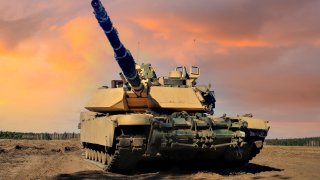A Total Loser: The M1A1 Abrams Tank in the Ukraine War
It takes years to master an Abrams. The Ukrainians were given months.
Russian social media is running wild with images of an American M1A1 Abrams Main Battle Tank (MBT) being captured by the Russian Army fighting in Ukraine. According to these Russian sources (take from them what you will), the Abrams in question is being sent back to Moscow to be reverse-engineered. Indeed, this is hardly the first American Abrams captured by Russian forces fighting in Ukraine.
As Military Watch Magazine has assessed, since September, “the rate at which Ukrainian forces have been losing Abrams tanks has increased significantly.”
And it isn’t just the Abrams MBT that has struggled in the muddy, blood-soaked killing fields of Ukraine. Most of the other classes of NATO MBTs have either been destroyed or rendered useless in Ukraine’s fight against the invading Russians. Even the much-ballyhooed German-built Leopard 2A6 MBTs have not fared as their proponents in NATO claimed they would.
An Incredibly Poor Performance
Most independent analysts assess that of the thirty-one Abrams tanks handed over to Ukraine, an astonishing twenty of them have been destroyed within the first year of their deployment to Ukraine. According to Military Watch Magazine, most of the kills that the Russians have enjoyed over the Abrams tanks have been conducted by the ubiquitous “kamikaze” unmanned aerial vehicles (UAVs) that both sides in the war have been using to terrorize each other.
More shockingly, at least one confirmed Russian kill of the M1A1 Abrams in Ukraine was achieved by an old Russian T-72B3 MBT (thereby proving this author’s long-running supposition that the T-72 is the best tank in the Ukraine War).
Multiple media sources have interviewed U.S.-trained Ukrainian tank crews, all of whom have expressed extreme dissatisfaction with the Abrams tank. In the summation of these tank crews, their Abrams tanks are plagued with technical issues, and there is very little active defense provided against the aforementioned threat posed by Russian kamikaze drones.
What’s more, the advances in anti-tank weaponry have complicated the ability of MBTs belonging to both sides in the Ukraine War to defend themselves.
In the case of Russia, their 9M133 Kornet dual-warhead anti-tank weapon is a nightmare for any Ukrainian tank (as much as the NATO-provided Javelin anti-tank system is a problem that Russian MBTs struggle to overcome).
The real question that Western strategists must answer is why the M1A1 Abrams has struggled to perform well in the Ukraine War.
Wider Implications For America
After all, the Abrams is America’s primary MBT, and the Pentagon is spending gobs of money on an updated variant of the Abrams, which will be the U.S. Army’s primary armor force for decades to come. However, if the M1A1 Abrams’ lackluster performance in Ukraine is any indication of its utility in a future war, then the Pentagon’s investment in this system might be a bad choice.
Is this really a case of the vaunted Abrams finally being made obsolete by the changing tide of warfare, or is this really a user error?
While it’s easy to simply say that the Americans have not kept pace with the changing face of war in the modern age, the fact remains that the M1A1 Abrams, along with the other tanks provided by NATO, such as the aforementioned German-built Leopards, are highly technical. It takes years for troops to master these systems. NATO expected Ukrainians under siege to learn the intricacies and innovate tactics for these systems in a few months’ time.
Making The New AbramsX Ready For A Future War
What’s more, the tanks in question had to undergo several retrofits to better comport with the radical demands of the Ukrainian battlefield. So, between the rapid technical changes along with the novice-level crews manning these systems, to say nothing of the absurdity of placing so much hope on what amounts to a small number of tanks against such a large Russian force, the Abrams’ experience in Ukraine was doomed from the outset.
That’s not to say that the Americans aren’t going to need to radically upgrade their existing fleet of M1A1 Abrams as well as to ensure that the new AbramsX the Pentagon is developing can better cope with the kind of anti-tank weapons and drones that adversaries will use against American MBTs in a future conflict (which is coming sooner than most people think).
Brandon J. Weichert, a Senior National Security Editor at The National Interest as well as a Senior Fellow at the Center for the National Interest and a contributor at Popular Mechanics, consults regularly with various government institutions and private organizations on geopolitical issues. Weichert’s writings have appeared in multiple publications, including the Washington Times, National Review, The American Spectator, MSN, the Asia Times, and countless others. His books include Winning Space: How America Remains a Superpower, Biohacked: China’s Race to Control Life, and The Shadow War: Iran’s Quest for Supremacy. His newest book, A Disaster of Our Own Making: How the West Lost Ukraine, is available for purchase wherever books are sold. He can be followed via Twitter @WeTheBrandon.
Image: ArChe1993 / Shutterstock.com.

